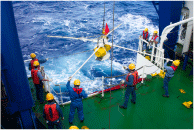
Australian OBEM
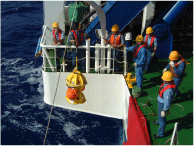
Australian OBM (Type 1)
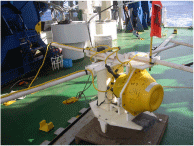
Australian OBM (Type 2)
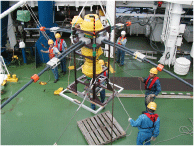
ERI-OBEM (Type 1)
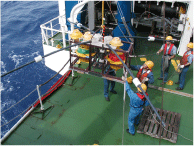
ERI-OBEM (Type 2)
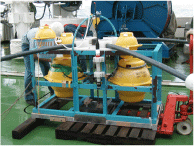
IFREE/JAMSTEC-OBEM
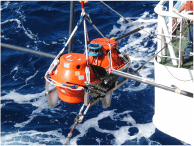
Kobe OBEM
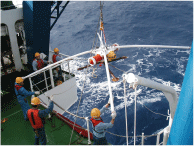
US OBEM
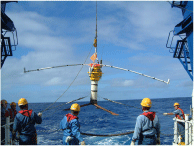
US OBE
KR06−12かいれい調査航海概要
研究課題名:
海底電位差磁力計による沈み込み・前弧・島弧・背弧系(中部マリアナ海域)の横断探査その2
(海底電位差磁力計、海底電位差計、海底磁力計の回収)
| 氏名 | 所属機関名 | 役職名 |
| 島伸和 | 神戸大学 | 助教授 |
| 後藤忠徳 | JAMSTEC | 研究員 |
| 馬場聖至 | 東京大学 | 助手 |
| 松野哲男 | 神戸大学 | 大学院生 |
| 辻野良輔 | 神戸大学 | 〃 |
| 米田朝美 | 東京大学 | 〃 |
| Rob L. Evans | ウッズホール海洋研究所 (米) | Associate Scientist |
| John Bailey | 〃 | Engineer |
| Alan Gardner | 〃 | Electric technician |
| Helmut Moeller | 〃 | Engineer |
| Anthony White | Flinders University (豪) | Associate Professor |
| Goran Boren | 〃 | 大学院生 |
| 青木 美澄 | 日海事 | 課長 |
| 井戸 美帆 | 〃 | 部員 |
調査海域:
中部マリアナ海域
(16°00.0′N、 20°00.0′N、141°00.0′E、151°00.0′Eの各経緯度線で囲まれる範囲)
実施期間:
2006年9月13日(水)〜2006年9月23日(土)
調査航海概要:
1. Purpose and Proposal
This project is a Japanese, US, and Australian collaborative research effort. We carried out a marine magnetotelluric transect across the central Mariana subduction system using ocean bottom electro-magnetometers (OBEMs), ocean bottom electrometers (OBEs), and ocean bottom magnetometers (OBMs) to provide a comprehensive image of the electrical conductivity structure of the Mariana island-arc system extending from the Pacific ocean to the West Mariana Ridge (remnant arc) through the Marina Trough. Subduction zones are fundamental to Earth recycling, controlling the return of crustal materials into the mantle and the partitioning of some fraction back to the surface. The Mariana subduction system is the classic example of an intra-oceanic arc, trench, and back-arc system. Our transect across the central Mariana subduction system, which includes three upwellings of serpentine diapirs, arc volcanism, and back-arc spreading, will address issues of hydration of the mantle wedge resulting from subduction and the nature and distribution of subsequent melting through estimation of the electrical conductivity structure. This will provide a breakthrough for understanding mantle dynamics related to plate subduction.
2 OBEM, OBE, and OBM Observation
Observations using OBEM, OBE, and OBM (Photo 1) were made at 40 sites across the Mariana Trench and back-arc spreading center. Site locations are given in Figure 1. The observations were made from December 2005 up to the recovery in September 2006.
 Australian OBEM |
 Australian OBM (Type 1) |
 Australian OBM (Type 2) |
 ERI-OBEM (Type 1) |
 ERI-OBEM (Type 2) |
 IFREE/JAMSTEC-OBEM |
 Kobe OBEM |
 US OBEM |
 US OBE |

Figure 1a.
A Location map of OBEMs, OBMs, and OBEs deployments through the Mariana
subduction system. Black dots show the locations of OBEM or OBM & OBE
recovered during KR06-12. The triangles show sites where only the OBM was
recovered. Crosses denote sites where OBEM recovery failed. Open circles
are sites at which OBEM remain deployed. Red circles are OBEM sites from
previous studies for which data are already in hand.

Figure 1b.
Location map of OBEM,OBM and OBE near the spreading axis of Mariana Trough. The symbols are the same as Figure 1a.
3. Preliminary Results
3-1. OBEM, OBM, and OBE recovery
Upon release, instruments were tracked to the surface using a variety of acoustic tracking tools. Some of the Japanese instruments utilized the inbuilt SSBL system on board the R/V Kairei to provide real-time x,y,z positions in the water column. Other groups used a combination of slant ranges and the ship position along with the starting position and measured ascent rates to calculate the position. By tracking the instruments closely we were able to accurately predict their surface times and positions and quickly find them with the ship.
Most instruments were recovered using a platform on the starboard side of the ship. The instruments were hooked by the crew and lifted by a chain hoist and crane onto the platform where the instrument was broken down and moved inboard. This operation was quick and took at most 30 minutes to complete. Larger instruments were hooked in the same way but were passed around the stern and lifted on board using the a-frame and a capstan.
Of the 47 instruments at 40 sites, 41 instruments (28 OBEMs, 7 OBMs, and 6 OBEs) at 35 sites were recovered. Two instruments remain deployed as the ship was forced to leave the survey area due to an oncoming typhoon, and the other four failed to respond to acoustic command and were not released.
3-2. Surface Geophysical Survey
We conducted a surface geophysical survey during the transit to site 1 and after site 38 to collect multi-narrow beam bathymetry, gravity field, and magnetic field data. Multi-narrow beam bathymetric feature was obtained by SeaBeam 2112, which also provides a backscatter image, which will be processed after the cruise. An XBT was done on 14th September at site 1. The DGPS (differential global positioning system) was used to derive the best ship location. Gravity field data were obtained from a shipboard gravimeter (KSS-31, Bodenseewerk Perkin-Elmer GmbH). The gravity field data at Yokosuka port measured by a gravimeter (CG-3M, Scintrex) will be used to correct the data drift. Magnetic field data were collected by a shipboard three component magnetometer (STCM: Isezaki, 1986), which can measure the vector of the geomagnetic field using deck-mounted fluxgate magnetometers and gyros.
4. Summary and Future Studies
We successfully recovered 28 OBEMs, 7 OBMs, and 6 OBEs at 35 sites. 3 OBEMs and and 1 OBE failed to respond to acoustic command and were not recovered. 2 OBEMs remains deployed as the ship was forced to leave the survey area due to an oncoming typhoon. The instruments measure geomagnetic and/or electric fields and these data will provide a comprehensive image of the electrical conductivity structure for the Mariana island-arc system extending from the Pacific Ocean to the West Mariana Ridge (remnant arc) through the Marina Trough. These results will provide a breakthrough for understanding mantle dynamics related to plate subduction.
Acknowledgement
We gratefully recognize the efforts of the officers and crew (Hitoshi Tanaka, captain) of the R/V Kairei during the cruise. We thank all the support staffs in JAMSTEC. This research was supported by Japan Society for the Promotion of Science (Grant-In-Aid for Scientific Research (B)(1)(No. 15340149), Japan-US Integrated Action Program, and "The 21st Century COE Program of Origin and Evolution of Planetary Systems"), "Stagnant Slab Project (No. 17037003)" in Ministry of Education, Culture, Sports, Science, and Technology, Flinders University, and U.S. National Science Foundation MARGINS program.